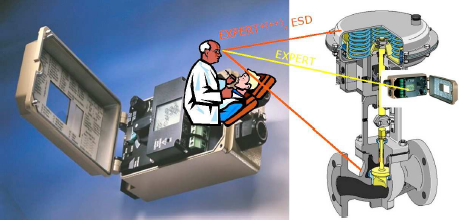Thursday, November 15, 2007
There are many real life experiences have shown that if valves are not work for substantial period, they can stick in the preset position. Past experiences also showed that once it is stuck at one position, system may experience difficulties to move from preset position and sometime failed to move it. Valve sticking / stuck at preset position could be cause by dirt accumulation, corrosion debris, corroded shaft break, etc.
On the hand, valves continuous move from one position to another position (e.g. full close to full open and vice versa) will minimize the chances of dirt and corrosion debris accumulation and get harden. A continuous moving valve with constant monitoring of it stroking time will enable alert of a out perform valve.
Partial stroke test is one of the testing procedures to ensure reliability and availability of valves. Normally the test is required for critical valve such as battery limit Emergency Shutdown Valves (ESDV). In addition, it helps to increase confident level and Safety Integration Level (SIL) of critical valves. Partial stroke test can be conducted manual by trained personnel and the testing can also be automated (PLC based) to minimize human error.
Nevertheless, there are some disadvantages of partial stroke test. Frequent testing of these valves promotes wear and tear and increases potential leakage and failure.
Following are some articles related to Partial Stroke Testing and you are encourages to read to enhance further your understanding.
On the hand, valves continuous move from one position to another position (e.g. full close to full open and vice versa) will minimize the chances of dirt and corrosion debris accumulation and get harden. A continuous moving valve with constant monitoring of it stroking time will enable alert of a out perform valve.
Partial stroke test is one of the testing procedures to ensure reliability and availability of valves. Normally the test is required for critical valve such as battery limit Emergency Shutdown Valves (ESDV). In addition, it helps to increase confident level and Safety Integration Level (SIL) of critical valves. Partial stroke test can be conducted manual by trained personnel and the testing can also be automated (PLC based) to minimize human error.
Nevertheless, there are some disadvantages of partial stroke test. Frequent testing of these valves promotes wear and tear and increases potential leakage and failure.
Following are some articles related to Partial Stroke Testing and you are encourages to read to enhance further your understanding.
- Need for an industry standard for ESD valves from engineering & safety point of view
- Partial Stroke Testing ESDV
- Partial Stroke Testing - Good & Bad and the Ugly
- The Partial Stroke Test as a module in the process safety concept
- Achieving High SIL Ratings with Partial Stroke Testing of Valves
- Should we install Butterfly valve for Pressure Relief Valve (PSV) isolation ?
- Another descrepancy found in API Std 521Jan 2007
- Controlled and Non-controlled Type Depressuring.
- How to apply valve equation in HYSYS Depressuring ?
- 12 Features required for Shutdown Valve (SDV)
- ERRATA - API Std 521, Pressure Relieving and Depressuring Systems
Labels: Emergency Shutdown, Safety


0 Comments:
Post a Comment
Let us know your opinion !!! You can use some HTML tags, such as <b>, <i>, <a>
Subscribe to Post Comments [Atom]
Home:
<< Home